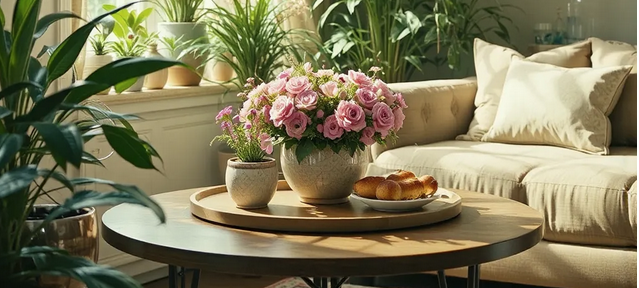Transform Your Living Space: Flowers & Plants Bringing Nature Inside
Bring serenity and vitality into your home by embracing the beauty of nature. Discover the benefits of incorporating flowers and plants indoors, from purifying the air to boosting mood and productivity. Create a harmonious space that connects you with the natural world and enhances your well-being.
4/13/20255 min read


The Aesthetic Appeal of Natural Plants and Flowers
The integration of natural plants and flowers into home decor can dramatically enhance the aesthetic appeal of any living space. By introducing greenery, one not only breathes new life into their environment but also creates a dynamic visual experience. The versatility of plants allows them to fit seamlessly into various interior styles, from minimalist to bohemian, each contributing uniquely to the overall design.
One of the major advantages of using natural elements is their ability to add color and texture. For instance, vibrant flowers can serve as focal points, drawing the eye and striking a contrast against neutral backgrounds. Popular choices like orchids, succulents, and peace lilies not only thrive indoors but also offer a variety of colors and shapes that can complement any decor. When selecting flowers and plants, consider color combinations that harmonize with existing furniture and wall colors. Using a monochromatic palette can create a serene atmosphere, while contrasting colors can energize a room.
Various arrangements of plants can also dictate the mood of a space. For example, a group of varied heights and species displayed on a windowsill can create a lush, garden-like effect, while strategically placing a larger plant in an empty corner can make the space feel more grounded and welcoming. Hanging plants can add dimension to walls, transforming them into living installations that captivate the eye. When designed thoughtfully, the incorporation of plants fosters a sense of balance, inviting natural beauty into designs that may otherwise appear cold or lifeless.
In decoration, the key to successful integration lies in selecting appropriate styles and carefully considering placement. The overall effect encourages not only visual delight but also promotes a sense of calm and well-being, making homes feel warmer and more inviting. By judiciously choosing and arranging natural plants and flowers, one can significantly elevate the aesthetic quality of their living space.
Health Benefits of Indoor Plants
Incorporating indoor plants into living spaces provides numerous health benefits that can contribute significantly to one’s physical and mental well-being. Among these advantages is the remarkable ability of plants to purify the air. Research conducted by NASA has demonstrated that various houseplants can effectively remove common indoor pollutants, including formaldehyde, benzene, and trichloroethylene. By enhancing air quality, indoor plants can help reduce the risk of respiratory problems and other health issues associated with poor air quality.
Moreover, indoor plants play a crucial role in increasing humidity levels. During colder months, indoor air often becomes dry due to heating systems, which can lead to discomfort and respiratory ailments. The presence of plants can significantly alleviate this issue; they release moisture vapor through a process known as transpiration. A study published in the "Journal of Physiological Anthropology" highlights how increased humidity levels can help reduce the occurrence of dry skin, sore throats, and sinus congestion, thus fostering a healthier indoor environment.
Additionally, the positive impact of indoor plants on mental health is noteworthy. Numerous studies have shown that the presence of greenery can reduce stress, anxiety, and even depression. A study from the University of Technology, Sydney, found that participants reported feelings of calmness and relaxation when surrounded by plants. Interactions with nature have been linked to lower cortisol levels—a hormone associated with stress. This suggests that simply being in an environment enriched with plants can promote an overall sense of well-being.
Overall, integrating indoor plants into everyday living environments not only enhances aesthetic appeal but also supports vital health aspects by improving air quality, increasing humidity, and reducing stress levels. Thus, the health benefits of indoor plants warrant serious consideration for anyone looking to transform their living spaces.
Creating a Sustainable Lifestyle with Indoor Gardening
The integration of indoor gardening into one’s living space is a vital step towards fostering a sustainable lifestyle. By bringing nature indoors, individuals can significantly reduce their carbon footprint while enhancing the environmental quality of their home. Indoor gardening not only beautifies spaces but also promotes ecological awareness through the cultivation of plants that play an essential role in air purification and biodiversity. Choosing native or low-maintenance species can simplify this process, making it more accessible for beginners and those with busy lifestyles.
When selecting plants for indoor gardening, it is advantageous to focus on native species as they are generally better suited to indoor climates. Not only do these plants require less water and maintenance, but they also provide essential habitats for local wildlife and contribute to the conservation of native ecosystems. Incorporating low-maintenance plants into your indoor garden can yield lush green spaces without demanding excessive time and effort. Popular options include pothos, snake plants, and succulents, which thrive in various conditions and require minimal watering.
Another significant component of a sustainable lifestyle is the practice of growing your own herbs and vegetables. This not only reduces reliance on store-bought produce, which often includes pesticides and excessive packaging, but it also ensures that your food is fresh, healthy, and free from harmful chemicals. Starting your own herb garden can be as simple as using small pots on a windowsill. Common herbs, such as basil, mint, and parsley, are relatively easy to grow and can enhance the flavors of your meals while encouraging healthier eating habits.
For beginners, starting small is key to success. Begin by selecting a few easy-to-grow plants and gradually expanding your collection as you become more confident in your gardening skills. Utilizing online resources, attending local gardening workshops, or joining community gardening groups can provide valuable support and information. By integrating these practices, indoor gardening can evolve from a hobby into a meaningful contributor to a sustainable and environmentally conscious lifestyle.
Tips for Caring for Indoor Plants and Flowers
Caring for indoor plants and flowers is essential for maintaining a healthy and vibrant living space. Each plant species has unique needs, but some universal tips can help your indoor garden thrive. The first critical aspect of plant care is establishing a suitable watering schedule. Overwatering is one of the most common mistakes. It is vital to check the moisture level of the soil before watering. For most houseplants, allowing the top inch of soil to dry out between watering is an effective guideline. However, some plants like succulents require less frequent watering, while tropical plants may thrive with more humidity.
Optimal light conditions are another vital component in ensuring indoor plants flourish. Understanding the light requirements of your plants—from low light to bright indirect light—allows you to place them where they can thrive best. South and west-facing windows generally provide the most sunlight, but be cautious of direct sunlight exposure that can scorch leaves. If natural light is limited, consider using grow lights as an alternative solution to provide necessary illumination for your plants.
Fertilization plays a crucial role in plant health, especially during the growing season. Using a balanced, water-soluble fertilizer every 4-6 weeks can promote growth and flowering. However, it is important to follow the recommended doses on the product label to avoid over-fertilization, which can harm plants. Additionally, keeping an eye out for pests is essential in indoor gardening. Regularly inspect your plants for any signs of infestation and promptly address issues using natural or chemical treatments as needed. Integrating these care tips tailored for various types of plants will help ensure your indoor garden flourishes, contributing to a more inviting and serene atmosphere.
Tranquility
Crafting natural products to promote overall wellness and tranquility.
email :-
House of Aya
© 2024. All rights reserved.
admin@houseofaya.co.uk
